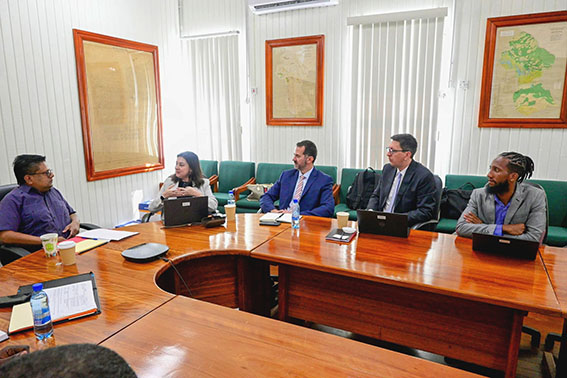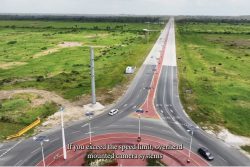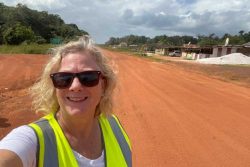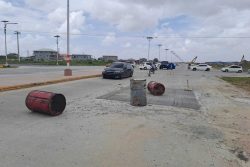`…(the) road safety situation in Guyana is concerning, with a road mortality rate of 15 deaths per 100,000 population’
The World Bank’s Board of Executive Directors has approved a new project to support Guyana in upgrading and rehabilitating the country’s road infrastructure.
A release from the World Bank yesterday said that the US$156 million Integrated Transport Corridors Project will focus on enhancing Guyana’s transport network in selected regions, ensuring it is better equipped to withstand natural hazards and provide safer, more reliable mobility.
There was no information in the press release on the financing terms. The government has come under consistent criticism for heavy spending of oil revenue and large borrowing on top of that.
The announcement yesterday followed a visit here by a World Bank team this week.
The release said that Guyana’s road infrastructure faces several challenges, particularly in the coastal regions, where roads are highly vulnerable to extreme weather events. It said that over 60% of the road network consists of smaller roads, many of which sit on low-lying coastal plains, making them highly exposed to the impacts of rising sea levels, increased rainfall intensity, and more frequent extreme weather events like storms and flooding. It said that the most recent flooding event in 2021 caused over US$100 million in damage to the agriculture and transport sectors.
“Poor road conditions hinder access to essential services like healthcare and education, disrupt economic activities, and isolate communities. Additionally, the road safety situation in Guyana is concerning, with a road mortality rate of 15 deaths per 100,000 population”, the World Bank said.
The project will focus on upgrading and rehabilitating key road corridors in parts of Guyana, with a particular emphasis on improving resilience to natural hazards. It will implement critical infrastructure improvements such as enhancing drainage systems, stabilizing slopes, and lifting embankments to prevent erosion to safeguard vital transport links that support agriculture, tourism, trade, and access to essential services.
The release said that the project will also prioritize road safety and inclusivity.
“This includes the safety assessment of the entire primary road network and road safety audits for selected roads, followed by the installation of road safety engineering solutions like crash barriers and traffic calming measures, and the creation of dedicated lanes for non-motorized transport, such as pedestrians and cyclists. Special attention will be given to high-risk locations like schools, hospitals, and markets. Mobility plans tailored to the needs of women and other vulnerable groups will feature in the project as well as road asset management systems, creating safer and transportation options”, the release stated.
“Guyana’s rapid economic expansion places increasing pressure on infrastructure, while the growing risks from natural hazards, such as flooding and storms, further challenge the country’s systems. This project will help Guyana’s road network keep pace with its growth by making it safer and more resilient,” said Diletta Doretti, World Bank Group Resident Representative for Guyana.
The project is funded through the World Bank’s International Development Association, the arm of the World Bank that helps the world’s low-income countries. Interestingly, Guyana’s income status has zoomed upwards as a result of oil revenues.
The project information document on the World Bank website said that the transport sector here is underdeveloped.
“Guyana’s infrastructure gap is significant, ranking 134 out of 141 countries for infrastructure in the 2019 Global Competitiveness Index, and its Logistics Performance Index rank was 113 out of 160 (2018). With a land area of over 214,000 km2, transport plays a crucial role in connecting its diverse communities spread across coastal plains, dense rainforests, and remote hinterlands”, it said.
It added that “Limited road connectivity to remote regions isolates communities, constraining access to markets, healthcare, education, and other essential services. This lack of connectivity also impedes food security and agricultural productivity and trade, as farmers struggle to transport their goods to markets efficiently, exacerbated by the country’s vulnerability to climate change. Moreover, poor road conditions contribute to high transportation and vehicle maintenance costs, reducing the competitiveness of Guyanese goods in both domestic and international markets”.
It stated that the road network in Guyana has approximately 7,970 km of roads, with an average of 19 percent comprising primary roads and 21 percent of feeder roads that link coastal agricultural areas to the primary road networks.
“The limited number of all-weather road corridors connecting the capital city, Georgetown, to other parts of the country, has restricted the growth of the logistics industry and impacted tradeable sectors. Guyana’s two main international land economic corridors are to the South (Georgetown-Linden-Roraima/Brazil) and to the East (Georgetown-Moleson Creek-Paramaribo/Suriname), and both need further development. At Moleson Creek, the Guyana – Suriname ferry is the only mode of connectivity to the eastern economic corridor, but this will change with the construction of the Corentyne River Bridge and a subsequent new high span bridge across the Berbice River”, the project document said.
“With the construction of the new bridges on the horizon, the road sections and links to the main economic corridors that connect the capital with Suriname and Brazil need major improvements. This is considered the missing link to achieving improved economic connectivity between Guyana, Suriname, and Brazil and to boosting trade, tourism, and agriculture productivity while strengthening cooperation among the three South American states”, the document said.









